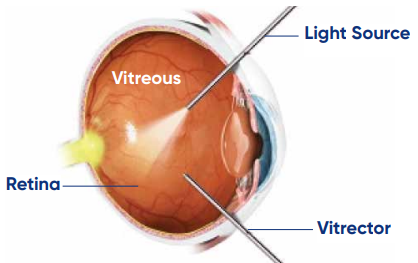What is vitrectomy surgery?
A Vitrectomy is the surgical removal of the vitreous. The vitreous is the clear, gel-like substance that fills the centre of the eye, making up approximately 2/3 of the eye’s volume. The removed vitreous is replaced over time by natural secretions of the eye.
Which eye conditions require vitrectomy surgery?
- Complications from diabetic retinopathy such as retinal detachment or bleeding
- Macular hole
- Retinal detachment
- Pre-retinal membrane fibrosis
- Bleeding inside the eye (vitreous haemorrhage)
- Injury or infection
- Complications related to previous eye surgery
What do I need to do in preparation for surgery?
Shower and wash your hair the morning of your surgery. Wear no make-up, deodorant, perfume, aftershave, nail polish or talc. Wear clean, comfortable clothing.
Take your regular medications as prescribed, unless advised otherwise by your doctor, anaesthetist, or pharmacist.
What happens during vitrectomy surgery?
Vitrectomy surgery is a day procedure that is most often completed under local anaesthetic with some sedation; this means you will remain awake for the duration of the procedure, and you will get to go home on the same day. In some cases, vitrectomy is performed under a general anaesthetic.
Under a microscope, the surgeon will make several tiny incisions on the sclera (the white part of the eye), insert microsurgical instruments through these incisions and then cut and remove the vitreous.
 Vitrectomy is often performed in conjunction with other procedures such as retinal detachment repair, cataract surgery, macular hole surgery, and macular membrane peel. The length of the surgery depends on whether additional procedures are required and the overall health of the eye.
Vitrectomy is often performed in conjunction with other procedures such as retinal detachment repair, cataract surgery, macular hole surgery, and macular membrane peel. The length of the surgery depends on whether additional procedures are required and the overall health of the eye.
When to seek help
Please attend Mater Hospital Brisbane’s Emergency Department if you develop any of the following symptoms:
- A deep ache or throbbing pain that does not respond to simple analgesia (Paracetamol or other over the counter pain medication)
Excessive pain or swelling that is unrelieved
Excessive pain or swelling that is unrelieved by rest and simple analgesia (Paracetamol)
Bleeding, excessive redness, swelling or discharge around the wound
Fever
Vomiting and/or the inability to tolerate fluids
Special techniques
The surgeon may use special techniques along with vitrectomy to treat the retina. Your surgeon will determine if any of these are appropriate for your eye.
Sealing blood vessels – Laser is sometimes used to stop tiny retinal vessels from bleeding inside the eye.
Gas bubble – A small gas bubble may be placed inside the eye to help seal a macular hole.
Silicone oil – After reattachment surgery, the eye may be filled with silicone oil to keep the retina in position
What to expect after having a vitrectomy
You will be discharged from Hospital the same day of your operation with an eye patch on. This patch must remain on until your post-operative clinic appointment the following morning.
After your operation there is a regime of eye drops to follow– you will receive instructions on when to commence your eye drops, as well as the prescriptions for the eye drops before you go home.
Discomfort immediately after the surgery and several days afterward is normal due to swelling around the eye. A scratchy feeling or occasional sharp pain is normal.
Ice compresses gently placed on the swollen areas (ice or frozen vegetables placed inside a resealable plastic bag work well) reduce the aching and soreness, along with use of simple analgesia (Paracetamol).
You should not attempt any of the following for at least 24 hours;
- Driving a motor vehicle
- Operate machinery
- Use domestic appliances
- Drink alcohol
- Care for infants without responsible help
- Sign legal documents,
- Make any important decisions
- Engage in strenuous exercise
Additional information
As vitrectomy is performed for different conditions, post-operative instructions will vary. You will be provided with specific instructions from your doctors and nurses after surgery and at your post-operative appointment the following morning.
What are the potential risks of vitrectomy surgery?
All surgical procedures have risks. However, if your eye surgeon recommends a procedure, they believe the potential benefits far outweigh the potential risks. Risk of this procedure include but are not limited to the following:
- Infection of the eye: This could cause loss of vision and requires treatment with antibiotics.
- Droopy eyelid: This may alter your appearance and can be disfiguring. Further treatment may be required.
- Retinal detachment: This will require further treatment and surgery.
- Glaucoma: An increase in pressure in the eye. This may require further treatment.
- Bleeding: Bleeding inside the eye can occur which may need further treatment.
- Cataracts: Clouding of the lens inside the eye. This may require further surgery.
- Vision loss or blindness: Can occur in rare cases.
Contact information
For any questions regarding your upcoming eye surgery, please contact the hospital via the following numbers, available Monday – Friday 8am – 4:30pm:
Mater Bookings Office (07) 3163 8444
Admin team for questions regarding your booking date, time, transport, updating details.
Eye Surgery Scheduler (07) 3163 8155
Nursing team regarding pre-surgery instructions for medications, fasting instructions, health conditions.
Mater Call Centre (07) 3163 3000
Regarding pre-op or post-op clinic appointments, or concerns after surgery.